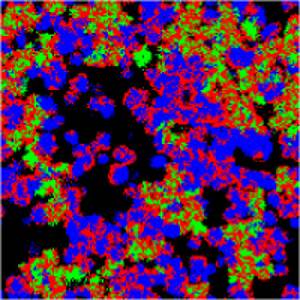微小的温室气体排放源:土壤微生物分解的气候反馈没有以前认为的可怕

Microbe model
土壤微生物分解的气候反馈是气候模型面临的最大不确定性之一。从国际应用系统分析研究所(IIASA)和维也纳大学的一项新研究的显示,这些反馈可能没有以前认为的那么可怕。
根据发表在《生态学快报》杂志上的一项新研究,土壤微生物动态变化令其在分解有机物时更有效、更灵活地,释放到大气中的二氧化碳比以前认为的更少。
“以前的气候模型只把土壤微生物看作一个黑盒子,”本文领衔作者Christina Kaiser说。这项工作是Kaiser的博士后研究内容。Kaiser现在是维也纳大学的助理教授,提出一个有助于曝光这些微生物过程的创新模式。
微生物和气候
“土壤微生物是地球上最大二氧化碳排放源之一,约化石燃料燃烧的六倍,”该研究的合著者、国际应用系统分析研究所(IIASA)研究员Oskar Franklin说。这些微生物分解有机物时,释放的温室气体如二氧化碳和甲烷到大气中。同时,地球上的树木和其他植物通过光合作用从大气中消耗等量的二氧化碳。
只要这两个通量保持平衡,一切都很好。
但随着温度的升高,土壤条件和分解过程发生改变。以前的土壤分解模型显示,营养失衡如缺氮等会导致更多的碳排放。“这是一个非常大的流量,甚至细微的变化就可能产生大的影响,” Kaiser说。“潜在的反馈效应相当高,很难预测。”
多样性是关键
然而,仍不清楚土壤中的微生物和凋落物如何应答不断改变的环境。原因之一是土壤微生物生活在不同的复杂群落中,相互影响,合作分解有机物质。
“一种微生物本身不能分解如枯叶等复杂底物,”Kaiser说。“这个系统如何响应环境变化,不是依靠单个微生物,而是取决于土壤群落中微生物种类数量和种间相互作用的变化。”
为了了解这些群落过程,Kaiser和同事们研发了一个能模拟复杂土壤动力学的计算机模型。该模型模拟了1立方毫米体积内10000个微生物之间的相互作用。模型显示了何种养分如何影响微生物代谢、相互作用、改变土壤群落,从而影响分解过程。
以前的模型将土壤分解看作一个单一过程,并假设营养失衡会导致低效分解,因而排放更多的温室气体。但新的研究表明,事实上微生物群落通过重组维持有效运作,排放的二氧化碳比先前预计的更少。
“这个模型极大地推进了对微生物分解的理解,并为我们提供了一个更清晰的土壤系统概貌,”另一作者维也纳大学生态学家Andreas Richter说。(编译:中国科学院成都生物研究所 王芋华,王海燕)
Microbial community dynamics alleviate stoichiometric constraints
during litter decay
Abstract Under the current paradigm, organic matter decomposition and nutrient cycling rates are a function of the imbalance between substrate and microbial biomass stoichiometry. Challenging this view, we demonstrate that in an individual-based model, microbial community dynamics alter relative C and N limitation during litter decomposition, leading to a system behaviour not predictable from stoichiometric theory alone. Rather, the dynamics of interacting functional groups lead to an adaptation at the community level, which accelerates nitrogen recycling in litter with high initial C : N ratios and thus alleviates microbial N limitation. This mechanism allows microbial decomposers to overcome large imbalances between resource and biomass stoichiometry without the need to decrease carbon use efficiency (CUE), which is in contrast to predictions of traditional stoichiometric mass balance equations. We conclude that identifying and implementing microbial community-driven mechanisms in biogeochemical models are necessary for accurately predicting terrestrial C fluxes in response to changing environmental conditions.
原文链接:http://onlinelibrary.wiley.com/doi/10.1111/ele.12269/pdf

